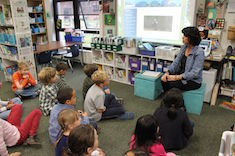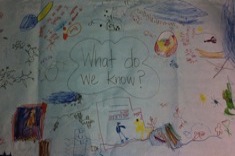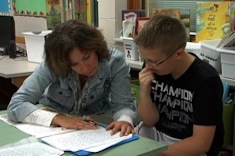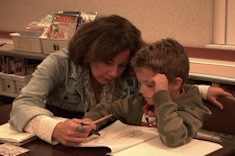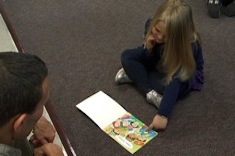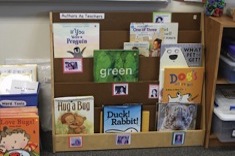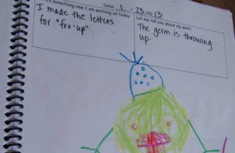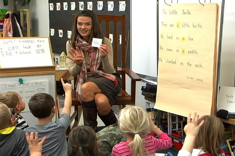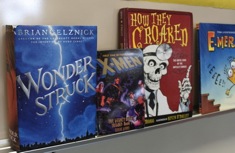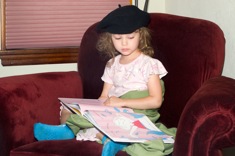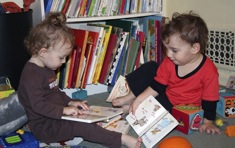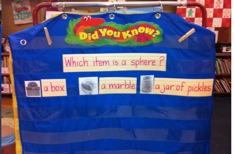Kindergarten
Latest Content
Formative Spelling Assessment
Max Brand has developed templates for grades K-2 and 3-5 to use for formative spelling assessments.
Penguins Are Amazing!: Informational Writing Comes Alive in Kindergarten
Can kindergartners do informational writing? Keri Archer finds the answer is yes, as she applies Common Core standards to inquiry work in her classroom.
Keep Going
Ruth Ayres has advice for moving forward, staying positive, and focusing on what’s important.
Powerful Conferences
Ruth Ayres explains how deciding the purpose of conferring in advance can lead to more powerful conferences.
Dandelions, Chinese, and Patience with Our Youngest Learners
Kelly Petrin meditates on the importance of trust and patience when looking for ways to connect with preschoolers.
Illustrations in Kindergarten: Conferring with Dalton
Ruth Ayres confers with kindergartner Dalton early in the year, focusing on his illustrations to build storytelling skills.
Learning from Kidwatching
Quiet kindergartners can be a challenge to understand when they are in the beginning stages of learning social and academic norms. Andie Cunningham uses observation to make sense of five-year-old Sierra’s learning.
Mentor Texts for “Versus” Stories
Shark vs. Train! Fork vs. Spoon! Versus stories are incredibly popular in writing workshops these days. Cathy Mere found herself struggling to teach narrative conventions to students writing versus tales, so she created a booklist of mentor texts.
Creating Your Own Kindergarten Assessment
Max Brand finds standard assessments don’t always give him the information he needs when working with kindergarten English language learners, so he develops his own tool for analyzing book handling skills.
Mentor Texts for Writing Endings
One goal of many primary teachers is to help students finish their drafts with an ending other than “The End” (or “they lived happily ever after”). Katie DiCesare shows her first graders many alternative examples, and she begins early in the year.
Using Pinterest for Professional Development
Franki Sibberson finds Pinterest is a useful tool for professional development.
The Minimalist: Essential Texts for Kindergarten Teaching
Max Brand develops a "Swiss army knife" booklist of texts that he can't live without when teaching young learners.
In Defense of Dictation
Leslie Woodhouse finds dictation is a critical tool for understanding young writers and their sense of story.
Routines to Build Independence Early in the School Year
Katie DiCesare explores how to develop routines early in the year, and includes advice to give to parents to build the home/school connection around expectations for independence.
Are You Excited About Next Year?
Kelly Petrin finds a bare classroom at the end of the year leads her to improvise with stuffed animals and literacy with her preschool students. The mix of play and reading is so successful that it changes her planning for the fall.
Adding to a Word Wall in Kindergarten
Mandy Robek introduces a new word to her kindergartners for their word wall.
Recommendations for Summer Reading Fun: Early Reader Chapter Books for Boys
Meghan Rose and Ruth Shagoury finish their summer fun for early readers series with a booklist for boys interested in chapter books.
Recommendations for Summer Reading Fun: Comics and Graphic Novels for Early Readers
Early readers love comic books and graphic novels. Meghan Rose and Ruth Shagoury give their top picks in their latest summer fun for early readers booklist.
Recommendations for Summer Reading Fun: Classic Books for Early Readers
Meghan Rose and Ruth Shagoury have written a series of booklists for early readers, perfect for sharing with parents looking for suggestions. The first installment tackles the classic books many of us cherish from our own childhood days.
Death in Books: Finding Our Way After Loss
Books can help children deal with the toughest challenges in life. In a new booklist, Andie Cunningham shares her top picks for stories about characters grappling with the death of a loved one.
Teaching Syllable Breaks in Kindergarten
In kindergarten, table groups are a natural and informal way to help groups of students learn new skills through eavesdropping. In this short video from Mandy Robek's kindergarten class, Mandy targets the same skill of defining syllables during individual conferences at the table so that the learning is reinforced for all.
Kindergarten I-Pick Minilesson
It’s never too early to help students learn to make wise choices for independent reading. Mandy Robek reviews the I-Pick strategy for choosing appropriate books with her kindergarten students.
Understanding the Middle East Through Children’s Literature (BOOKLIST)
Sheiks, harems, and terrorists — the stereotypes of the middle east from popular culture may not be realistic, but they sure are pervasive. Ruth Shagoury and Andie Cunningham find authentic alternative views to present to children in their new booklist.
Every Picture Tells a Story
Max Brand describes how he uses images to build reading and writing skills among his kindergartners.
Research IS the Project (Primary Research Series)
Heather Rader blurs the line between research and presentation in the final installment of the primary research series.
A Literary Taste of Home (Home is Where the Books Are Series)
Meghan Rose may live in Los Angeles, but the home of her heart will always be New England. In this booklist, she shares her favorite picture books about everything from the Red Sox to Maine blueberries to give her children a sense of where she grew up.
KLWL: Ordering Research (Primary Research Series Part 3)
Heather Rader looks at the importance of frontloading information for young learners in the third installment of the primary research series.
The “Tys” of Student Research: Safety and Credibility (Primary Research Series Part 2)
Heather Rader shares the second installment in our primary research series.
Kindergarten Moments Count: Question of the Day
Keri Archer makes the most of the time her kindergarten students spend transitioning into her classroom with her Question of the Day.
Letter Practice Transition in Kindergarten
Mandy Robek “warms up” her kindergartners brains for literacy work with a simple one-minute alphabet activity.
Browse Content By
Type
Category
- Assessment Tools
- Big Fresh Archives
- Booklists
- Choice Numeracy
- Classroom Design
- Common Core
- Community Building
- Conferring
- Content Literacy
- Digital Literacy
- English Language Learners
- Equity
- Family Relations
- Free Samples
- Guiding Groups
- Leadership
- Literacy Coaches
- Mentor Texts
- Minilessons
- New Teacher Mentors
- Podcasts
- Poetry
- Quote Collections
- Reading Strategies
- Self Care
- Struggling and Striving Learners
- Talking and Listening
- Teacher Study Groups
- Teaching Reading
- Teaching Writing
- Word Study and Vocabulary
Author
- Melissa Quimby
- Nawal Qarooni
- Gwen Blumberg
- Julie Cox
- The Lead Learners
- Hannah Tills
- Josie Stewart
- Ruth Metcalfe
- Mallory Messenger
- Becca Burk
- Jodie Bailey
- Vivian Chen
- Mary Brower
- Tiffany Abbott Fuller
- Stephanie Affinito
- Ruth Ayres
- Leigh Anne Eck
- Heather Fisher
- Shari Frost
- Julie Johnson
- Suzy Kaback
- Gigi McAllister
- Shirl McPhillips
- Melanie Meehan
- Cathy Mere
- Debbie Miller
- Tara Barnett and Kate Mills
- Tammy Mulligan
- Dana Murphy
- Bitsy Parks
- David Pittman
- Brenda Power
- Heather Rader
- Matt Renwick
- Mandy Robek
- Christy Rush-Levine
- Gretchen Schroeder
- Jen Schwanke
- Brian Sepe
- Katherine Sokolowski
- Stella Villalba
- Jennifer Vincent
Grade Level
Choice Literacy Membership
Articles
Get full access to all Choice Literacy article content
Videos
Get full access to all Choice Literacy video content
Courses
Access Choice Literacy course curriculum and training

